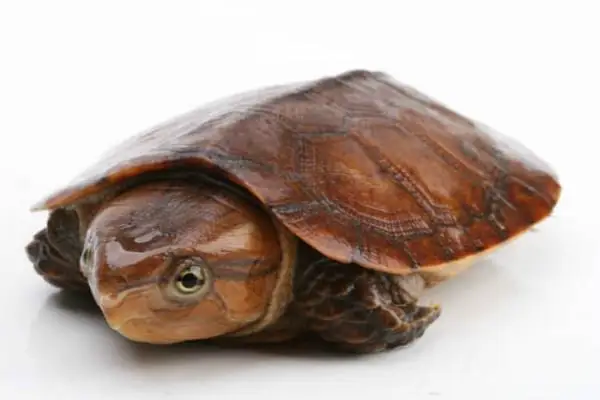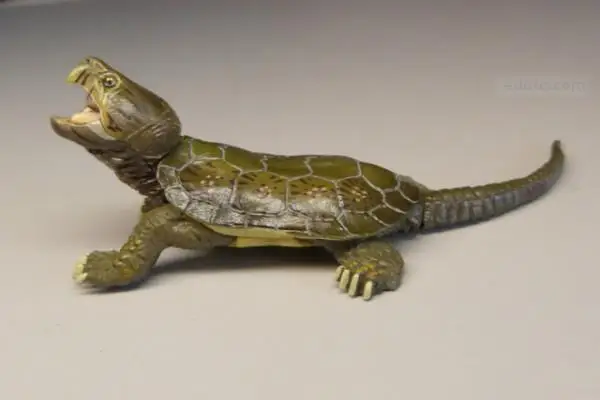Variety Overview
English Name: Platysternon megacephalum
Also Known As: Big-headed Turtle, Flat-chested Turtle, Parrot Turtle
Habitat: Highland streams in Southern China, Laos, Myanmar, Thailand, and Vietnam.
Size: Small
Care Difficulty: Easy
Morphological Features and Identification
Known scientifically as Platysternon megacephalum (Big-headed Flat-chested Turtle), colloquially referred to as Flat-chested/Ying/Parrot/Eagle Beak Dragon Tail Turtle—a unique species boasting dragon-like scaled/sturdy tails coupled alongside parrot-resembling heads/eyes/mouths earning affectionate nicknames such as Parrot Turtle due to these charming features: large triangular heads adorned by keratinous plates hooked upper beaks mimicking eagles’ no external eardrums plus brownish-oval-flattened-centered-smooth-edged carapaces.
On March 10th 2015 within Yongding County Longyan City Fujian Province history’s largest Eagle Beak Turtle was found measuring impressive dimensions—90cm length x50cm width x28cm height weighing hefty 80kg!
Olive-colored smaller/flatter plastrons connect via ligaments bearing marginal plates underpinning gray-tiled-scaled limbs—hind ones longer possessing sharp claws save outer partially-webbed fingers/toes aiding terrestrial/water mobility alike.
Long-tailed individuals sometimes exceeding own carapace lengths sport ring-like short scales atop making them standout among Chinese turtles unable retract heads/limbs into protective shells instead leveraging sturdy/sharp-limbed agility resembling qilins dragging dragon tails during rapid moves/owl-like predator watchfulness while still/eagle-soaring side-walks embodying mythic dragon-qilin-turtle traits sans phoenix thus highly ornamental roaring off larger threats including mountain eagles cultivating rare collectible Green Hair variants fetching up-to $3000 exports surpassing other green-haired types especially flaunting green growths across heads/mouths/tails/limbs/plastrons akin Azure Dragons wading waters impressively so!
Male variants feature longer slightly-concave-central-chest-area plastrons thick-tailed cloacal openings distanced ~2.5cm from bases whereas females exhibit flatter wider non-concave central chests closer ~1.5cm distance cloacal openings from bases respectively.

Maintenance Tips
The alligator snapping turtle is known for its wild nature; it’s far more aggressive than other turtle species and doesn’t easily adapt to captivity. Newly acquired turtles shouldn’t be placed directly into tap water but rather kept in a dry place with some water sprinkled around them to maintain moisture. Gradually introduce them to live prey like tadpoles, young frogs, and earthworms. If they start eating well, house them individually at first; after three to five days of acclimatization in aged natural water (preferably river or pond water) at depths of 10-15 cm (4-6 inches). Once they’re eating regularly on their own, you can offer poultry offal or small live fish as food.
As they become accustomed to their environment, you can gradually increase the water depth up to about 30 cm (12 inches). If they refuse food for an extended period, continue offering live bait while injecting vitamins B and C for additional nutrition to maintain their health.
Alligator snapping turtles thrive in clean water but since bait is introduced into their habitat which can leave residues that pollute the water quickly turning it foul-smelling—it’s crucial to maintain good water quality by regularly changing it: after feeding during spring/summer seasons; at noon during autumn; no changes needed during winter.
Native to rocky mountain streams with shallow waters promoting captive breeding of these unique turtles is essential Jiang Zhanglin from Longtouge Animal Breeding Farm has successfully achieved large-scale breeding of these turtles Their sharp claws—five on front limbs four on hind limbs—webbed toes enable fast crawling climbing They resemble owls when still often hissing opening hooked mouths when threatened Against larger threats sudden roars scare predators away
Highly ornamental due unique appearance amusing postures peculiar behaviors bring joy Kept glass tanks movements resemble golden dragons playing sea providing refreshing feeling Uncarved shells natural artworks multiple shells various materials dyed exquisite crafts unique characteristics become even more astonishing.

Breeding Information
Turtles reach sexual maturity at around five or six years old when they weigh about 250 grams each. Mating occurs from September to October in the evenings when temperatures are between 20°C and 25°C. Egg-laying starts in June of the following year as water temperatures rise and continues until mid-August.
Turtles prefer laying their eggs from dusk till dawn but may extend into early morning hours up until around 8 a.m. It’s advisable not to disturb female turtles during nighttime egg-laying activities.
By morning, most female turtles will have left their nests and returned to their ponds. You can locate eggs by looking for signs of nesting holes, carefully dig them out, and place them flat in an egg collection container lined with about three centimeters of moist fine sand.
After collecting eggs, smooth out the nesting area by hand; if it’s too dry, sprinkle some water to maintain humidity for future egg-laying sessions.
Place fresh fertilized eggs into an incubation box filled with approximately twenty centimeters of compressible fine sand. Bury each egg two to three centimeters deep in this sand layer and cover them with a damp cloth.
Maintain an eighty percent humidity level by watering once or twice daily and keep temperatures between twenty-five degrees Celsius and thirty degrees Celsius. After fifty to sixty days, baby turtles will hatch.
For newly hatched turtles, no feeding is required within their first one to three days; simply disinfect them briefly using an eight-point-five percent saline solution before transferring them into a rearing box lined with fine sand.
After three days, start feeding them small fish, shrimp, earthworms along with small amounts of rice. With attentive care over sixty days, they can then be moved into larger rearing ponds for further growth.
